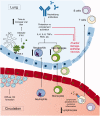Mechanistic inferences from clinical reports of SARS-CoV-2
- PMID: 32459123
- PMCID: PMC7265107
- DOI: 10.1080/23744235.2020.1769853
Mechanistic inferences from clinical reports of SARS-CoV-2
Abstract
SARS-CoV-2 was identified as the causative pathogen in an outbreak of viral pneumonia cases originating in Wuhan, China, with an ensuing rapid global spread that led it to be declared a pandemic by the WHO on March 11, 2020. Given the threat to public health posed by sequelae of SARS-CoV-2 infection, the literature surrounding patient presentation in severe and non-severe cases, transmission rates and routes, management strategies, and initial clinical trial results have become available at an unprecedented pace. In this review we collate current clinical and immunologic reports, comparing these to reports of previous coronaviruses to identify mechanisms driving progression to severe disease in some patients. In brief, we propose a model wherein dysregulated type I interferon signalling leads to aberrant recruitment and accumulation of innate immune lineages in the lung, impairing establishment of productive adaptive responses, and permitting a pathologic pro-inflammatory state. Finally, we extend these findings to suggest possible treatment options that may merit investigation in randomized clinical trials.
Keywords: COVID-19; COVID-19 mechanisms; COVID-19 pneumonia; SARS-CoV-2; immune response.
Figures

References
-
- He X, Lau EH, Wu P, et al. . Temporal dynamics in viral shedding and transmissibility of COVID-19. Nat Med. 2020;26(5):672–675. https://www.medrxiv.org/content/10.1101/2020.03.15.20036707v2 - DOI - PubMed
Publication types
MeSH terms
LinkOut - more resources
Full Text Sources
Miscellaneous
